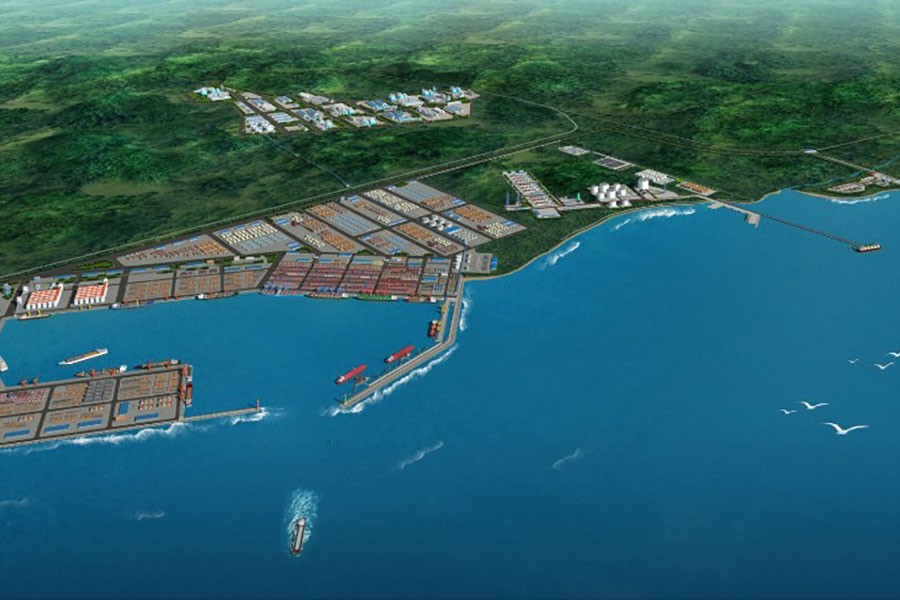Work on construction of the deep seaport at Matarbari in Cox's Bazar is progressing at a snail's pace. The outbreak of the coronavirus pandemic is responsible for such slow growth of construction of the sea port.
The deep seaport is expected to help the country handle rising volumes of exports and imports and ease the pressure on Chattagram port. The project is expected to be completed in 2026. Matarbari in Maheshkhali of Cox's Bazar will be the fourth port in Bangladesh.
Of the estimated cost, the Japan International Cooperation Agency (Jica) is giving most of the fund. The rest of the fund will be borne by the Chattagram Port Authority (CPA).
Export and import activities have increased significantly in recent years. As such, the country needs a deep seaport to support the growing international trade and the economy. Under the project, a 26.7-kilometre approach road will be constructed. The approach road will be an elevated expressway.
The idea of the deep seaport at Matarbari was conceived after the government started a coal-based power plant project in the area, as a wider channel and a port would be required to bring in the fuel for the plant. As part of the 1,200 megawatt power plant project on the same site, almost 90 per cent of the work for creating an artificial channel with 14.5-kilometre length, 250-metres width and 18 metres depth has already been completed. On the northern side of the channel, a 1,750-metre breakwater has been constructed in order to protect the channel from the force of the sea waves and mitigate sedimentation.
The CPA now plans to enhance the width of the channel by 100 metres, as per requirements of the proposed seaport. The channel already has a depth of 16 metres and it would be extended by up to 18 metres. The Karnaphuli channel of the Chattagram port has only 9.5 metres depth.
The planned draft of the channel would allow bigger vessels with a capacity to carry up to 8,000 TEUs (twenty-foot equivalent units) containers to come in, which is four times the capacity of the ships now accommodated at the Chattogram port channel. The first phase of the port with two terminals - a 300-metre multipurpose terminal for bulk cargo carriers and a 460-metre container terminal - would be completed by 2026. Once the first phase is completed, the port would be able to handle 0.8 million TEU containers annually.
The Chattagram port handled 2.89 million TEU containers in 2019 and its capacity would be at best 5.0 million TEUs even after the implementation of several ongoing expansion projects. The Matarbari port would certainly play a supplementary role in catering to the extra volume of exports and imports in future.
Establishment of such a mega port is expected to bring about a revolutionary change in the country's economy. With facilities for docking larger vessels, the mega port can turn this region into a commercial hub of international standard benefiting all users. Through opening the mega port for China, north-eastern states of neighbouring India and for landlocked countries like Nepal and Bhutan, the wheel of the country's economy can be moved faster.
The erstwhile alliance government did some ground work in the making of a deep seaport. An international tender was floated and 14 local and international firms were short-listed for conducting the feasibility studies on the deep seaport.
Several surveys recommended that the Moheshkhali in Cox's Bazar would be the most suitable site. When the government initially selected Kutubdia as the deep seaport site, it took experts and port specialists in the port city by surprise.
The Netherlands Economic Institute (NEI, while considering the probable sites, found Moheshkhal channel in Cox's Bazar the best place for a deep sea port. The NEI study looked into all aspects for setting up a deep seaport, including major costs, onward transport, provisions of port facilities, sheltered water and dredging. High cost of transport to and from Chattagram, Mongla and other Inland destinations and origins were also considered in the survey.
To develop a deep seaport at Matarbari at Moheshkhali with a draft of 65 feet was also considered the cheapest and easiest. The total investment to develop Matarbari as a deep seaport initially for 150,000 DWT vessels would stand at $159.3 million.
The government may convert Matarbari initially as a deep seaport for lighterage vessels only and can save huge foreign exchange now being spent on lighterage in the open sea at Chattagram. A canal through Thailand and Myanmar joining the Gulf of Siam (Thailand) and Bay of Bengal to bypass the Singapore straits is being completed soon and for that the international shipping routes will come closer to Moheshkhali.
Meantime, lack of attention in developing communication and port infrastructures retards the growth in trade between Bangladesh and the northeastern states of India. While potentials of formal cross-border trade remain largely untapped, lack of trade facilitating supports encourage unofficial trade of estimated $800 million, depriving both the countries of revenues.
However, the New-mooring container terminal (NCT) would give land-locked Indian northeast access to the sea. These states would be benefited by the deep seaport in Chattagram as it has been planned to establish a regional hub there.
A highway linking the neighbouring landlocked countries will also be required to facilitate transport of goods from the mega seaport. Setting up an airport with all sorts of facilities close to the mega seaport will also be required to benefit the businessmen travelling frequently to and from Chattagram.
With facilities for docking larger vessels, the mega port could turn this region into a commercial hub of international standard benefiting all users.


